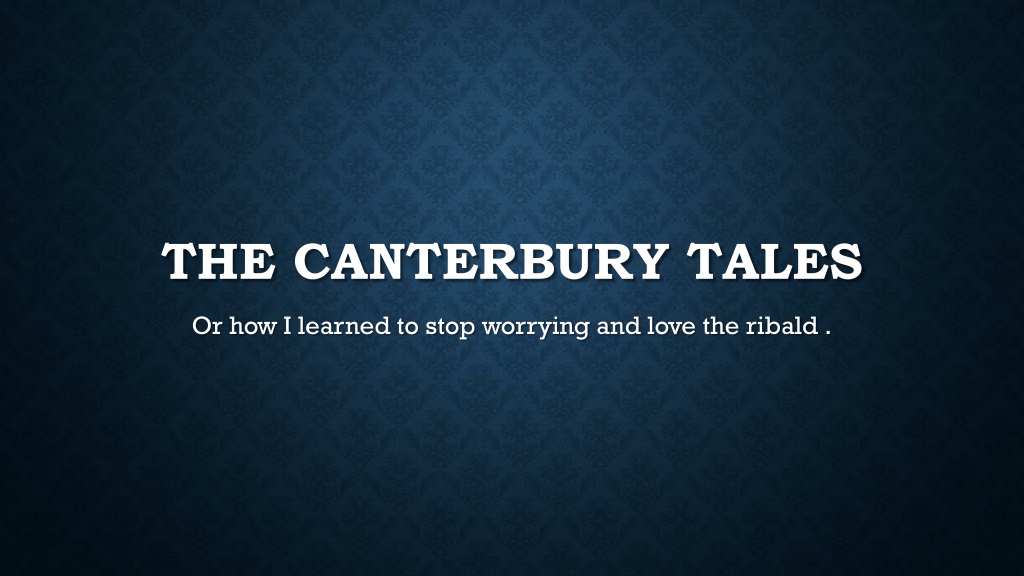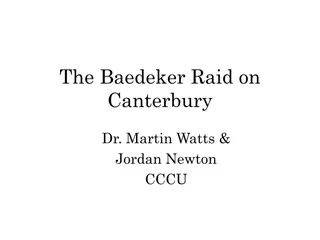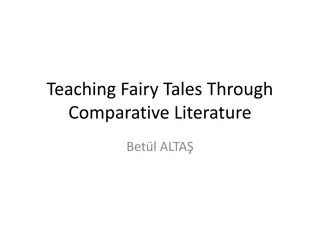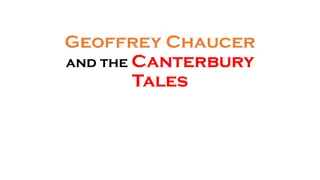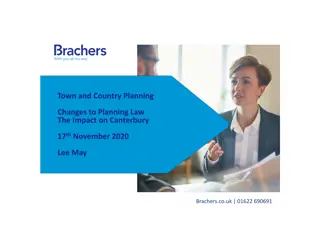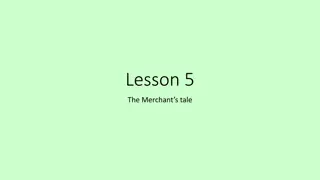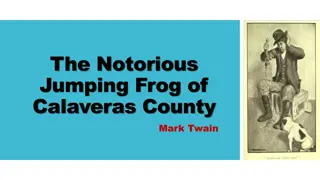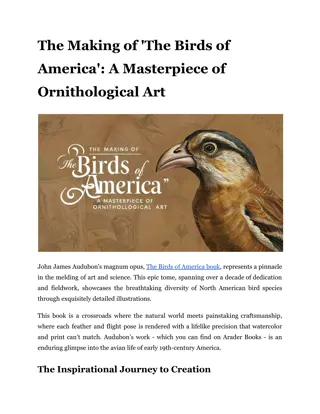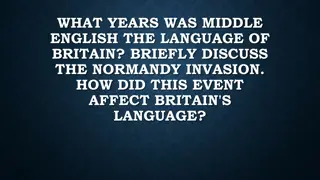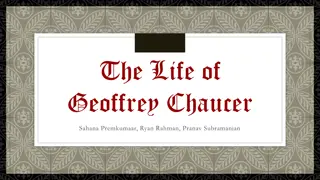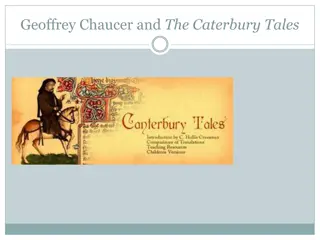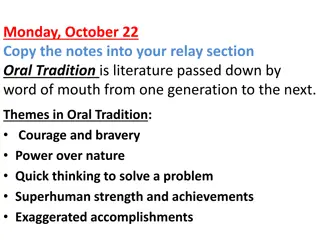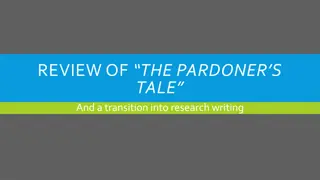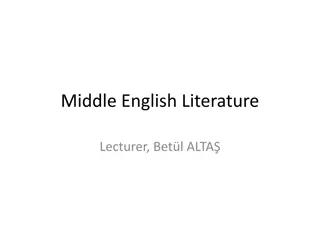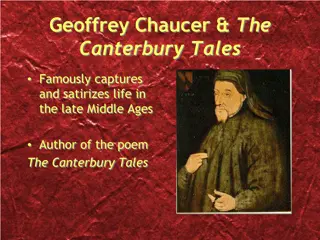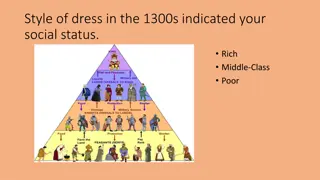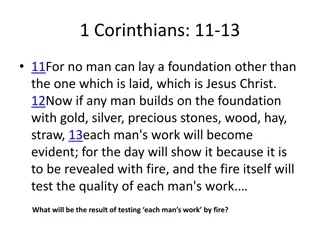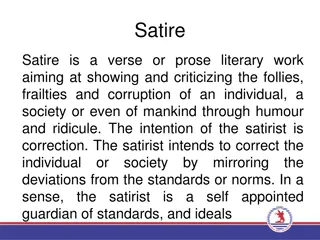Exploring The Canterbury Tales: A Journey Through Chaucer's Masterpiece
Delve into Geoffrey Chaucer's timeless work, The Canterbury Tales, where 29 pilgrims embark on a trip to Canterbury Cathedral. Each pilgrim tells stories on the journey, showcasing diverse characters and occupations of the Middle Ages. Discover the depth of characterization, the frame narrative structure, and the competition for the best tale. Uncover the blend of realism and exaggeration, reflecting a snapshot of medieval society through this literary gem.
Download Presentation

Please find below an Image/Link to download the presentation.
The content on the website is provided AS IS for your information and personal use only. It may not be sold, licensed, or shared on other websites without obtaining consent from the author. Download presentation by click this link. If you encounter any issues during the download, it is possible that the publisher has removed the file from their server.
E N D
Presentation Transcript
THE CANTERBURY TALES Or how I learned to stop worrying and love the ribald .
The Middle Ages (1066-1485) Geoffrey Chaucer (1343-1400) The Canterbury Tales (1387)
WHAT IS IT? 29 pilgrims (plus the host) are on a trip to visit the holy relics at the Canterbury Cathedral. They will start and end at the Tabard Inn, and the host is the owner of the inn. The host decided to go along, and declares that every pilgrim will tell two stories on the way to Canterbury and two stories on the way back. Chaucer is one of the pilgrims, and says that it s his job to report exactly what was said, even if he doesn t agree with it.
WHAT IS IT? CONT. The person who tells the best stories (as decided by the host) wins a free dinner when they get back to the Tabard Inn. Supposed to be 120 stories, but only 24 completed. The stories were written in English ( the language of the common folk) as opposed to French or Latin, the languages of the aristocracy and the church The pilgrims reflect realistic and exaggerated people of the middle ages. There is a knight, squire, rich wife, clerics of all sorts, a chef, student, craftsmen, millers, .
CHARACTERS The pilgrims represent many different occupations, classes, and personalities. Some characters, like the Friar, the Doctor, and the Pardoner, were really greedy Some characters, like the Knight, the Parson and the Plowman, were virtuous and honorable people.
CHARACTERIZATION Chaucer reveals the personality and morals of each person by: Telling us directly what the character is like Describing how the character looks and dresses Presenting the characters words and actions (what kind of stories do they tell?) Revealing characters private thoughts and feelings Showing how other people respond and feel about the character
FRAME NARRATIVE Sets the stage for the story. Chaucer chose a popular literary device called a frame story or frame narrative A frame story is a collection of narratives (stories) that are put together with a uniting central structure. For The Canterbury Tales, the uniting structure is the structure of a pilgrimage a group of unique and diverse individuals who come together to go on a journey together. The Princess Bride a grandfather is reading a book to his sick grandson, and we hear the story in the process. The Arabian Nights (of which Aladdin is a story) is also a frame story, as is the modern book by Amy Tan, The Joy Luck Club
Quick Review Old English Period 485-1066 (Anglo Saxon) Middle English Period 1066-1485 (Norman Conquest 1066) changes Life Mead Hall, Cold, Brutal, Focused on warfare Life Feudal castle, growing population, disease, more people crowded, unsanitary Religion Paganism Religion Roman Catholic Church Women Household, owned land, husband had to pay woman to get married, had babies, equal partners Women No rights, no voice. Women subservient to men, status completely dependent on husband or father s status Government Tribal system, there was a king, but the land wasn t settled system of comitatus Government Feudalism
FEUDALISM Land is better than gold. The king grants land to nobles, and nobles grant land to knights, and knights grant land to serfs, who are only useful if they make the land productive. This was largely undone by the bubonic plague: before the plague there were limited resources (land) and insatiable demand (hungry people). After the plague wiped out half of the population, the teeming millions gained bargaining rights. This led to an emerging merchant class.
CHIVALRY System of ideals and social codes governing the behavior of knights and gentlewomen precepts of chivalry adhering to one s oath of loyalty to the overlord observing certain rules of warfare Adoring a woman (not physical or sexual in (nature, very chaste, based on putting her on a pedestal)
WHY DOES THIS MATTER? The Canterbury Tales is like a snapshot in time. Chaucer wanted to show the wide range and variety of people who were alive during the Middle Ages. People are people. Humanity doesn t necessarily change, and it helps us to understand others and ourselves if we see a connection between people s lives from a different time period and today. Chaucer was an innovator by focusing on non-heroic characters and portraying them accurately, and by telling their story in the everyday vernacular.
THE PARDONERS TALE The Pardoner may be the worst out of the pilgrims Chaucer (the author) suggests that he may not really be a man In the Prologue to his tale, the Pardoner boasts of his evil ways and greed he says that he gladly lies about his relics, and tells stories about greed to make his listeners feel guilty and buy pardons from him.
THE PARDONERS TALE SYNOPSIS 3 young men (called rioters) are drunk, and see a coffin passing by They ask a young boy at the tavern to tell them what happened The tavern boy tells them their friend is in the coffin; Death came and took him The tavern boy hints that death has been lurking about, and is easily found The 3 rioters go looking for death, and meet an old man on the way They are unkind and insensitive to the old man who tells them to treat people as they would like to be treated They tell him to reveal Death s location, and he says to look under a nearby tree.
PARDONERS TALE SYNOPSIS, CONT. Once the 3 rioters reach the tree, they find piles of gold, and immediately greed takes over and they forget about avenging their friend s death. They can t risk being seen stealing the gold in the daytime, so they decide to wait til dark. The two oldest send the youngest to town, and while he is away, they plan to stab him and take his share of the gold. The youngest decides to poison the older two and take both of their shares The two older rioter stab the younger, then drink the wine and die. Irony.
THE PARDONERS TALE After he finishes the tale, the Pardoner tries to sell pardons to the other pilgrims EVEN AFTER he told them that he s a liar, and he only does all this out of greed. The Pardoner tells the pilgrims that death comes unannounced, so they should buy a pardon just in case. So two morals; 1. don t be greedy. 2. treat people as you wish to be treated
WIFE OF BATHS TALE The Wife of Bath is a wealthy lady that s been married 5 times. She is well educated and uses historical and mythical stories to prove her point, for example, the tale of King Midas to show that women can t keep secrets Her story is about a Knight who rapes a girl, his punishment is to find out within a year and a day what women really want, or be executed if he fails. He asks everywhere, but no one agrees what women want He finds an old woman, who agrees to tell him the answer in return for a favor She says women want power over their husbands.
WIFE OF BATHS TALE, CONT. The favor the old woman wants is to marry the knight He says no, for 3 reasons: 1. His higher status/rank 2. she s old 3. she s ugly The Knight defends #1 by saying he s noble and she s not, but the old woman says nobility is God-given, not inherited like money. She asks if he d rather have a faithful, old, ugly wife or a young, hot, slutty wife, and he says she can choose for herself, whereupon she transforms into a young, hot, faithful wife. Yay justice?
